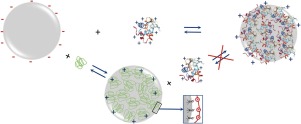当前位置:
X-MOL 学术
›
Colloids Surf. B Biointerfaces
›
论文详情
Our official English website, www.x-mol.net, welcomes your
feedback! (Note: you will need to create a separate account there.)
Competitive inhibition of protein adsorption to silica surfaces by their coating with high density charge polyelectrolytes.
Colloids and Surfaces B: Biointerfaces ( IF 5.4 ) Pub Date : 2020-03-30 , DOI: 10.1016/j.colsurfb.2020.110993 Felipe Hornos 1 , Rocío Esquembre 1 , Javier Gómez 1
Colloids and Surfaces B: Biointerfaces ( IF 5.4 ) Pub Date : 2020-03-30 , DOI: 10.1016/j.colsurfb.2020.110993 Felipe Hornos 1 , Rocío Esquembre 1 , Javier Gómez 1
Affiliation

|
The adsorption of proteins to silica surface is a common process mainly governed by the electrostatic attractive interaction between the pH-dependent negatively silica surface and the positive charges of the biomolecule. This process often reduces the conformational stability of the adsorbed protein and may reduce its biological functionality mostly due to multimolecular processes such as aggregation and fibrillation. Here we show that high-density charge cationic polyelectrolytes may successfully compete with the protein for the silica surface containing deprotonated-silanol groups. Therefore, the coating of silica surfaces with these cationic polyelectrolytes precludes the adsorption of the protein to the solid surface. Intensive water washing of the polyelectrolyte-coated silica surfaces had does not result in polyelectrolyte release (even at moderate ionic strength) maintaining the solid surface protected from protein adsorption.
中文翻译:

通过用高密度电荷聚电解质包被二氧化硅,可竞争性抑制蛋白质吸附到二氧化硅表面。
蛋白质吸附到二氧化硅表面是一个常见的过程,主要受pH依赖性负二氧化硅表面和生物分子正电荷之间的静电吸引相互作用支配。此过程通常会降低吸附蛋白的构象稳定性,并且可能主要由于多分子过程(例如聚集和原纤化)而降低其生物学功能。在这里,我们表明高密度电荷阳离子聚电解质可以成功地与蛋白质竞争含有去质子化硅烷醇基团的二氧化硅表面。因此,用这些阳离子聚电解质在二氧化硅表面上的涂层阻止了蛋白质吸附到固体表面上。
更新日期:2020-03-31
中文翻译:

通过用高密度电荷聚电解质包被二氧化硅,可竞争性抑制蛋白质吸附到二氧化硅表面。
蛋白质吸附到二氧化硅表面是一个常见的过程,主要受pH依赖性负二氧化硅表面和生物分子正电荷之间的静电吸引相互作用支配。此过程通常会降低吸附蛋白的构象稳定性,并且可能主要由于多分子过程(例如聚集和原纤化)而降低其生物学功能。在这里,我们表明高密度电荷阳离子聚电解质可以成功地与蛋白质竞争含有去质子化硅烷醇基团的二氧化硅表面。因此,用这些阳离子聚电解质在二氧化硅表面上的涂层阻止了蛋白质吸附到固体表面上。









































 京公网安备 11010802027423号
京公网安备 11010802027423号